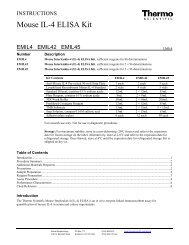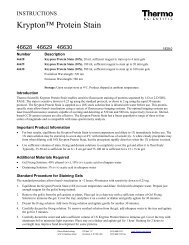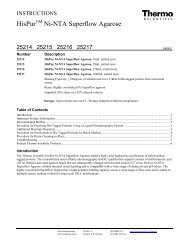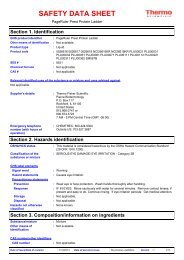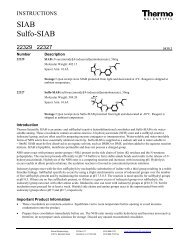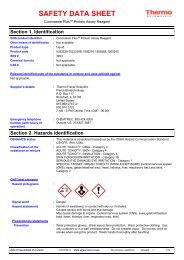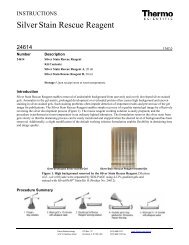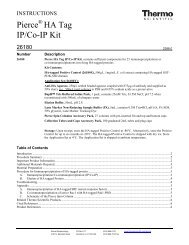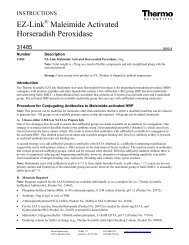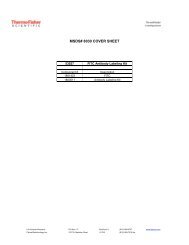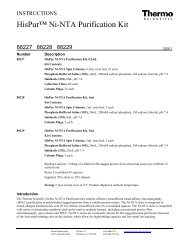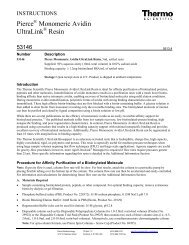Thermo Scientific Pierce Protein Assay Technical Handbook Version 2
Thermo Scientific Pierce Protein Assay Technical Handbook Version 2
Thermo Scientific Pierce Protein Assay Technical Handbook Version 2
You also want an ePaper? Increase the reach of your titles
YUMPU automatically turns print PDFs into web optimized ePapers that Google loves.
Coomassie Dye-based <strong>Protein</strong> <strong>Assay</strong>s<br />
General Characteristics of Coomassie-based <strong>Protein</strong> <strong>Assay</strong>s<br />
(Bradford <strong>Assay</strong>s)<br />
Coomassie-based protein assays share a number of characteristics.<br />
The Coomassie (Bradford) <strong>Protein</strong> <strong>Assay</strong> produces a nonlinear<br />
standard curve. The Coomassie Plus (Bradford) <strong>Assay</strong> has<br />
the unique advantage of producing a linear standard curve over<br />
part of its total working range. When using bovine serum albumin<br />
(BSA) as the standard, the Coomassie Plus <strong>Assay</strong> is linear from<br />
125 to 1,000µg/mL. When using bovine gamma globulin (BGG)<br />
as the standard, the Coomassie Plus <strong>Assay</strong> is linear from 125 to<br />
1,500µg/mL. The complete working range of the Coomassie Plus<br />
<strong>Assay</strong> covers the concentration range from 125 to 1,000µg/mL for<br />
the tube protocol and from 1 to 25µg/mL for the micro protocol<br />
(Figures 2-3).<br />
Coomassie dye-based protein assays must be refrigerated<br />
for long-term storage. If ready-to-use liquid Coomassie dye<br />
reagents will be used within one month, they may be stored at<br />
ambient temperature (18-26°C). Coomassie protein assay reagent<br />
that has been left at room temperature for several months will<br />
have a lower color response, especially at the high end of the<br />
working range. Coomassie protein assay reagents that have<br />
been stored refrigerated must be warmed to room temperature<br />
before use. Using either cold plates or cold liquid Coomassie dye<br />
reagent will result in low absorbance values.<br />
The ready-to-use liquid Coomassie dye reagents must be mixed<br />
gently by inversion just before use. The dye in these liquid<br />
reagents spontaneously forms loose aggregates upon standing.<br />
These aggregates may become visible after the reagent has been<br />
standing for as little as 60 minutes. Gentle mixing of the reagent<br />
by inversion of the bottle will uniformly disperse the dye. After<br />
binding to protein, the dye also forms protein-dye aggregates.<br />
Fortunately, these protein-dye aggregates can be dispersed<br />
easily by mixing the reaction tube. This is common to all liquid<br />
Coomassie dye reagents. Since these aggregates form relatively<br />
quickly, it is also best to routinely mix (vortex for 2-3 seconds)<br />
each tube or plate just before measuring the color.<br />
Net Absorbance (595nm)<br />
1.75<br />
1.50<br />
1.25<br />
1.00<br />
0.75<br />
0.50<br />
0.25<br />
0.00<br />
0<br />
500<br />
1,000<br />
1,500<br />
<strong>Protein</strong> Concentration (µg/mL)<br />
BSA<br />
BGG<br />
2,000<br />
Figure 2. Color response curves obtained with <strong>Thermo</strong> <strong>Scientific</strong> <strong>Pierce</strong><br />
Coomassie Plus (Bradford) <strong>Assay</strong> using bovine serum albumin (BSA) and<br />
bovine gamma globulin (BGG). The standard tube protocol was performed<br />
and the color was measured at 595nm.<br />
Net Absrobance (595nm)<br />
1.75<br />
1.50<br />
1.25<br />
1.00<br />
0.75<br />
0.50<br />
0.25<br />
0.00<br />
0<br />
500<br />
1,000<br />
1,500<br />
BSA<br />
BGG<br />
<strong>Protein</strong> Concentration (µg/mL)<br />
Figure 3. Color response curves obtained with <strong>Thermo</strong> <strong>Scientific</strong> <strong>Pierce</strong><br />
Coomassie (Bradford) <strong>Protein</strong> <strong>Assay</strong> using bovine serum albumin (BSA) and<br />
bovine gamma globulin (BGG). The standard tube protocol was performed and<br />
the color was measured at 595nm.<br />
2,000<br />
22<br />
For more information, or to download product instructions, visit www.thermoscientific.com/pierce



